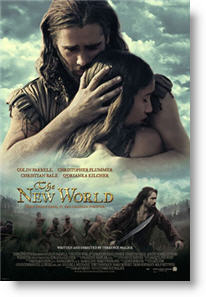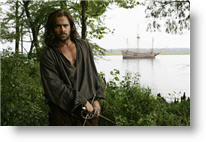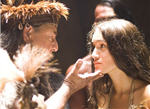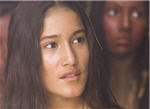The New World
 for some intense battle sequences.
for some intense battle sequences.
Reviewed by: Chris Monroe
STAFF WRITER
| Moral Rating: | Better than Average |
| Moviemaking Quality: |
|
| Primary Audience: | Adults |
| Genre: | Historical Adventure Romance Drama |
| Length: | 2 hr. 30 min. |
| Year of Release: | 2006 |
| USA Release: |
January 13, 2006 (wide) DVD release: May 9, 2006 |
| Featuring |
|---|
| Colin Farrell, Christopher Plummer, Christopher Newport, Q’Orianka Kilcher, Christian Bale, Noah Taylor, David Thewlis, Irene Bedard |
| Director |
|
Terrence Malick |
| Producer |
| Sarah Green |
| Distributor |
“Once discovered, it was changed forever”

The original film “The New World” contains a story about an old world, created by a director whose gifts come from another world. A true artist and certainly a poet, Director Terrence Malick has forsaken taking another twenty-year hiatus (as he did from 1978 to 1998) before making his latest film about the English arriving and settling in America. He has conceived, once again, a beautiful production that at its very heart engages its audience in a love story amidst adverse circumstances and harsh conditions. Its themes are intricate and moving, and clearly resonate with his three other films “Badlands”, “Days of Heaven”, and “The Thin Red Line”.
It is Virginia 1607 when three ships arrive from England filled with people eager to begin a new life in a new land. On board is Captain John Smith (Colin Farrell) who is being held prisoner for treason, but soon released and commissioned by Captain Newport (Christopher Plummer) to lead a brigade upriver and find food. The mission is to meet with natives and conduct a trade for necessities, but in the process all Smith’s men are lost, and he alone survives. It is in captivity that Smith meets the beautiful young Native American girl “Pocahontas” (Q’orianka Kilcher) and falls helplessly in love with her. Because of their bond, each of their lives is inexorably different, and while their love is true, it is not always ideal.
As with most of his movies, Malick refrains from using foul language and nudity to tell his story. There are some intimate situations between John Smith and Pocahontas, but the emphasis is on them talking and looking each other in the eyes rather than emphasizing something sexual. A few times Pocahontas does have a somewhat meager outfit on, but as Producer Sarah Green explained, women of these tribes actually went topless. Green says that the reason they chose not to have the women portrayed this way is because they wanted this film to be seen by everyone. The film does carry a PG-13 rating due to some intense battle scenes, but these refrain from being gratuitous as well.
The issue of Pocahontas’s explicit faith in Christ is expressed towards the end of this film in a brief scene where she is baptized. At this point she has fully decided to become a Christian. Besides this, there is not much emphasis placed on her Christianity, per se. However, throughout the course of the story, both her and John Smith are portrayed as highly spiritual people. As with all of Malick’s films, there is a voice-over narration by various characters, and at times reveals not only their inner thoughts, but also divine prayers to God. These soliloquy-like moments in this film are certainly open to interpretation, and include such statements as, “Come, Spiritwe rise from out of the soul of you,” (Pocahontas); “Who are you, whom I faintly hear? Who leads me ever on? Where? I will not die until I find it,” (Smith); “Father, where do you live? Show me your face. Give me a sign,” (Pocahontas); and, “Lord, we have gone away from You.” (Smith)
There is too much to appreciate about the poetic filmmaker Terrence Malick. It seems that his work truly lies in what makes film the exceptional medium that it is, namely story, photography, and natural acting—and how he is able to orchestrate these elements harmoniously. Besides the fact that the film is shot entirely on location (around the actual area that these historical events originally occurred in Virginia), Malick’s process is very much an organic one. For example, he only uses natural lighting while filming. Furthermore, actors Q’orianka Kilcher and Christian Bale shared how Malick would often have them scrap their lines if they were getting in the way and hindering the emotion and nonverbal communication occurring during a scene. Malick’s approach is one that supports Green’s statement that his films have a “very deep understanding of humanity,” and that this film, “The New World”, is a “love story in a natural setting.”
As for the historical accuracy of the film, it is noted that there is poetic license taken to tell this story. The original journals of John Smith and John Rolfe (Christian Bale) were utilized and incorporated in writing the script, but the goal was not to make a documentary about the events. Malick has used these resources, but has also interpreted their ideas, inserting some of his own, and rewritten them more poetically. At the same time the film does include actual unarguable events, such as how Pocahontas was a life-saving aid to Smith and the English people. In Smith’s journals he writes, “She [Pocahontas], next under God, was the instrument to preserve this colony from death, famine and utter confusion.” This fact is undoubtedly portrayed in the film.
This film is more like the story of Romeo and Juliet than a movie such as “Braveheart”. It is not out to rewrite history, but does seem to explore the intricacies of a relationship between a man and a woman, namely John Smith and Pocahontas, and how it may have been between them. You may not find the action within this film that you anticipate, but it is one that will certainly not leave you bereft of meaning.
Violence: Moderate / Profanity: Minor / Sex/Nudity: Minor
See our interview with the Producer of this film, Sarah Green.
See list of Relevant Issues—questions-and-answers.


The beauty of the scenery took my breath away. It took a certain relaxing into the pace and style of this director in order to fully appreciate what was happening, and it certainly is a plus to know the historical story before seeing this movie. For instance, I knew nothing about the second man in Pocohontas' life, and was quite thrown when he came into the picture. But I was so impressed with him, his willingness to give up his wife because he loved her so much, that it made the story much more rich. I wish every young man would model his romantic life after this character, a truly Godly man.
Good / 5
Better than Average / 4
I think that we, as Christians, have become a poor lot indeed, if we cannot see Jesus Christ or God displayed in art unless His name is mentioned in our western understanding. One of Malick’s greatest themes in his films is our relationship with God, and I think that in “The New World”, Malick does just that. We hear John Smith praying to God, and more so we see “Pocahontas” praying to God throughout the film [though her experience with God is obviously different from our Western understanding, but it is in no way less spiritually reflective]. I think that, as Christians, we need to let go of our childish understandings of films and see when a director is reaching out to challenge contmeporary ideas of not only film, but also society.
I cannot convince those who did not like this film to like it, but I can tell those who are considering to go see it that if you want to see a conventional movie go see “King Kong” or “The Chronicles of Narnia”. If you are like me, and have been waiting to see something more, something beautiful and reflective then “The New World” is what you are looking for. It is a film with few equals.
Out of fear of being long winded, I just want to comment on the beautiful cinematography, the quiet, pensive, incredible performances of all the actors, the breathtaking music by James Horner, and the intricate set peices and costumes, that they themselves give us a rare window to see what life was like for European settlers in North America. Peole say Colin Farrel wasn’t a good choice for John Smith, but I thought his performance was the best in the film, his eyes and expressions communicated the emotions of love and loss, as well as the ambition that his character goes through. Dialogue in the movie is rare, but I found the reflections of characters to be so insightful and beautiful that dialogue was unimportant. I cannot emphasize enough the greatness of this film, and I hope there are others out there who feel the same way.
Excellent! / 5
Good / 4
The film is more about Pocahontas’ journey in life than the exploration of America. Kilcher was mesmerizing in her portrayal of the Native American heroine. I also enjoyed how the rest of the Native Americans were represented. They came across as kind, loving, noble people who had a deep spiritual sense of life even though they were not yet exposed to the truth of the gospel to set them free from many of their superstitions.
What I found offensive was how the film portrayed Pocahontas’ understanding of God AFTER her conversion to Christianity. It remained the same! This left me wondering if Malick the film’s director gave any significant importance to the real Pocahontas’ Christian faith. Her baptism scene lasts about five-seconds and if the viewer blinks, it might be missed all together.
I screened this movie on DVD… She continued to call God “mother” and presented prayers and offerings of thanksgivings to the “great sun” (not the Son of God). See never calls God “father” before or after her Christian conversion but instead continually calls upon the divine feminine which leaves me to suspect the director is trying to imply all roads lead to the One True God. However, according to Jesus this is untrue because the Son stated that He alone was “The Way, The Truth and The Life” and also clearly taught how one ought to pray.
This may sound trivial to some but I believe it is important because there are basic Christian precepts that cannot be altered to appease the casual seeker or else the Christian faith will lose its savor and be one among the many false “New Age” religions that permeate our society today. We are called to worship God in “spirit and in truth.” This may come across as being discriminatory but then again, truth always discriminates against falsehood. …
Offensive / 4
Moral rating: Better than Average / Moviemaking quality: 3
However, the story needs help. My mom said she was completely confused about the plot, and I came to the conclusion that the editing, writing and length of the movie, just make it too hard to really enjoy. I was thinking there was going to be Christian values in this movie, but the only thing you might learn about Christ from this movie, is that He’s an uncaring God who doesn’t protect or provide for His people (the priest dies pretty early on). The really big problem though, is the fact that “mother Earth worship” is explicitly expressed throughout the entire film, almost as if that’s the point of the movie, to promote this false religion.
Bottom line: This movie is tragic love story with great scenery that leaves you feeling sad and wanting to watch a better movie when you get home.
Good / 4
Good / 4
Average / 1
Another thing that disturbed me was the movie’s blatant political correctness. In the movie, the white people are cruel and uncivilized, while the Indians are kind and civilized; the Christians are bad, the non-Christians are good; the white people are prejudiced and the Indians are not. This is contrary to a Christian worldview that declares that everyone is a sinner by nature and by choice. I would not recommend this movie to anyone! Since it is not fit for children or teens to watch it is also not fit for adults.












My Ratings: Better than Average / 5